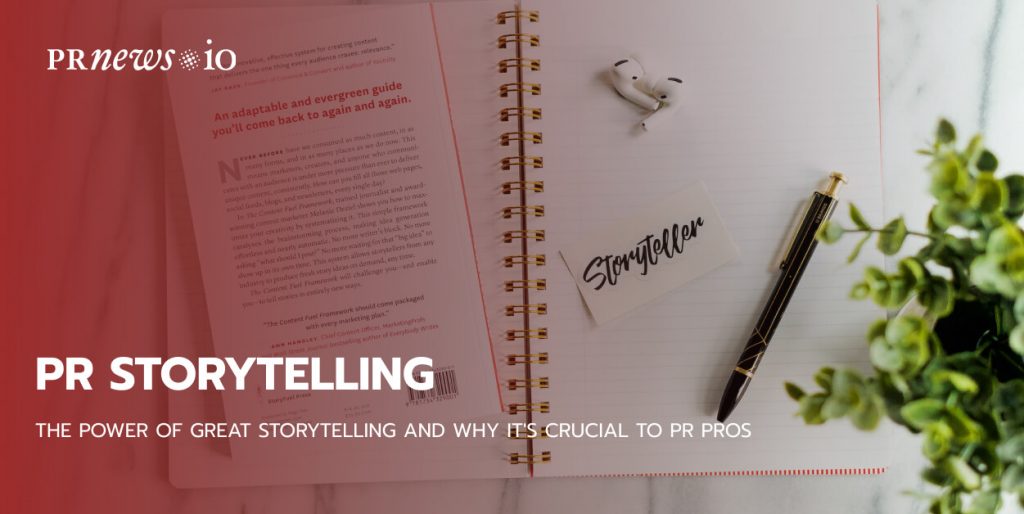
PR storytelling (or the ability to tell stories) is something everyone talks about, but no one knows what to do about. Namely, how to use PR storytelling to promote a company or brand.
What Is This Phenomenon—PR Storytelling?
PR storytelling has established itself as a fairly effective means of building external and internal corporate communications in modern business since stories are an integral element of people’s lives due to the peculiarities of the human psyche and act as a tool for understanding and transferring experience, value and cultural identification.
“Marketing is storytelling.”
— Seth Godin
This format of communication—a natural and flexible way to interact with the audience—provides for a cognitive act with the effects of involvement and entertainment. Emotions are added to the rational component, which repeatedly increases the memory of the received information and becomes part of the listener’s experience. The audience turns on the imagination, and mentally, the listener is transferred to the described situation, empathizes and enters into interactive interaction.
An important task of the storyteller is to maintain a balance between content based on real events and a fictional plot. To solve this problem, you can use real history to present the present state of affairs, after which you smoothly go to a hypothetical picture to describe the desired future.
Good PR Storytelling, What Does It Look Like?
Several PR storytelling principles help make history more effective:
- Use an introduction to the plot of a typical representative of the target audience of the company.
- The problems described in history should be close to real-life.
- The character must have more pronounced qualities than an ordinary person—be more intelligent, motivated, purposeful.
- The storyline should be swift.
- Company stories can be combined with a common concept on the principle of the series, which will show the effect of synergy.
“The most powerful person in the world is the storyteller. The storyteller sets the vision, values, and agenda of an entire generation that is to come … ”
— Steve Jobs
Among the characteristics of good PR history are the following:
- Novelty. Editors love when they intercept fresh stories and readers do not like outdated news. To confirm that, just read an old newspaper.
- Relevance. History should cause emotions among readers (and journalists), so it should feel the human factor. For example, “scientists made a breakthrough” or “a manager changes policy after a crisis in the company.” Readers like it when they can associate the heroes of history with themselves or learn something from them. And do not forget that your story should meet the theme of the publication because the editor of a business magazine is unlikely to be interested in news from the world of music.
- Significance. “The company introduced a new computer” does not sound very significant, but “the company introduced the smallest/fastest/cheapest computer”—a completely different matter. Of course, “meaningful” does not always mean sensational. The main thing is that people have a reason to publish and read your story.
- Attractiveness. If you work in a highly specialized area, many people interested in your business are far away, so try to convey information in a more accessible and interesting form. One way is to make predictions for the future: “Thanks to our new chip, one-day computers will become twice as cheap as they are now.” Another way is to share a story of creation. If you are asked to talk about the creation of penicillin or the light bulb, you will most likely recall the scientific component and the story of the moment of the discovery. Analogies also help: “If this plane were a car, it would be a Ferrari and not a Range Rover.”
- Focus presence. Journalists believe that readers are very quickly switching attention. And so consider not only journalists but also scientists. Therefore, editors prefer to tell one story from one point of view at a time.
Content Marketing Platform
- 100,000+ media publications;
- get backlinks to your product;
- scale work with content distribution.
For PR storytelling to fulfill its main purpose, it is not enough to just come up with a story. Companies use PR storytelling as a means of communication that aims to create a positive perception of the brand. The story should be aimed at the target audience and appeal to the values of the people who make up this audience, as well as be submitted in the right place at the right time. But, it should be properly designed.
“Effective content marketing is about mastering the art of storytelling. Facts tell, but stories sell.”
— Brian Eisenberg
Additional Tips
When you have a basis for history, you need to think about the details:
- Add suspense. Even now, in an era of fast scrolling, getting acquainted with history is a linear process. Therefore, it is very important to be able to provide readers with enough information to answer their questions, but at the same time hold some of the facts so that they continue to read.
- Raise the stakes. Hollywood says that if the scene is too boring, you need to put a gun in it. Heart rates immediately rise because someone can be killed. If you reduce the degree of passion, you can make a simple conclusion: to be effective, history must be exciting.
- Be honest. The truth is always more interesting and more effective than fiction. Besides, sooner or later, people will find out if you were dishonest, and trust in the brand will be undermined.
- Give a lesson. If you get acquainted with your story, the reader thinks: “And what was all this?” Consider, you have lost his trust. And you missed the opportunity to convey your key message. Therefore, make it clear to the audience how the experience you described affected you and your company, tell us what you learned and let readers learn from your example as well.
- Use the data. Data-driven stories generate more trust, increase the likelihood that the media will be interested in them and become insider sources. At the same time, excess data can complicate perception, so some experts recommend focusing on 1-2 key statistics, graphs or tables.
- Visualize. Graphs, tables and other ways to visualize data that contains numbers allow you to absorb information faster and easier. However, the value of different types of data visualization differs depending on the history and what information you need to convey. Linear graphs, area charts and histograms are suitable for demonstrating how trends have changed over time. Also, histograms perfectly demonstrate comparison and rating. At the same time, your graphics and tables should not be incredibly complex and beautifully designed—usually, the simplest graphics are read best.
- Try taking a video. When it comes to PR storytelling, we usually imagine the text. However, the video can sometimes tell the story even better. It can be very short and does not contain words at all, and at the same time have great power.
Well-designed stories appeal to their target audiences’ values and emotions, ensuring the emergence of a stable emotional connection between the company and consumers or between brands and consumers, as well as the transmission and absorption of the values reported by these stories.
Today, PR storytelling is almost the most effective method to turn a boring topic into exciting text or video, so it is very actively used in marketing.
Online Publicity Workbook
- 100+ content ideas for your B2B startup;
- ideal for do-it-yourself publicity plans;
- schedule your PR campaign in advance.
Industry Experts About PR Storytelling
Leszek Dudkiewicz, head of marketing at US Passport Photo

Stories help to establish an emotional connection with the customer and make them stay with the brand for longer. PR storytelling also is a powerful tool for building brand authenticity and personality.
We live in an information-saturated world. During an ordinary walk, we encounter dozens of ads with infused colors and filled with CTA slogans. Amidst this chaos, it’s no wonder we try to find a way to survive and simply “turn off” our brains. Banner blindness is a mechanism that allows our tired minds to rest. If we were to pay attention to every message around us, we would probably go crazy quickly.
On the other hand, there is also information that is worthy of our attention and that could change our lives for the better. Yet they are easy to overlook. And this is where storytelling plays a major role. A well-told story draws you in like a fine movie. You can find a part of yourself in it and become curious about the next step.
Good storytelling goes straight to the heart of your audience. When writing about your brand, tell about things that matter to your audience, the kind of things they can identify with, something they can relate to and something they need to make a choice about.
Angel Martins, marketing specialist at one of the UK’s leading digital marketing agencies, Finsbury Media Digital Marketing Agency

Storytelling is an essential part of releasing an effective PR article. Implementing an effective story will help you build more awareness around your brand, create an emotional connection and generate a certain feel for your brand publicity.
When developing your story, it is essential to create something that is newsworthy and relevant to your industry. Don’t publish anything that won’t engage users; you must focus on creating compelling content. Make sure that the story you write aligns with your brand’s overall message.
The story you release has the ability to shape public opinion and influence the behavior of the public in regards to your business. Make sure that the story you come up with is memorable and pushes a certain narrative about your company and image.
When completed effectively, storytelling is one of the best methods for driving positive public relations results.
Clare Jones, Digital Outreach and PR Manager for Custom Neon

Starting a PR campaign in the early days can be a bit daunting and difficult to know where to start, especially if you don’t yet have a story to tell or you are in a particularly competitive space.
It’s easy to get sucked in by the myriad of online press release distribution services that promise great exposure, but in reality, if you don’t have a story that would be of interest to someone outside of your organization, you shouldn’t waste your time on press releases.
Developing a successful PR strategy is a slow burn and all about building relationships and strategic communication between your organization and the outside world.
Look within your operations and identify some talking points that could potentially be newsworthy. Do you have unique selling points? Are you supporting local charities or businesses, giving back to the community, or hosting competitions for school children? Have you won any awards? Do you have a creative product or perhaps serviced a celebrity client? Can you offer any business advice? Do you have any whacky work perks for your team, or have you initiated incredible sustainability measures? How are you supporting minority groups, etc? There is always a story to tell, but it needs to be true, of interest, authentic, consistent and credible to ultimately build trust.
Great PR campaigns are all about building a positive public perception of your brand, but the very premise of any campaign should focus more on reputation than recognition in order to build strong foundations.
PR begins in the heart of your organization, the way you treat your customers, your staff, the integrity of your products and the pride you place in your operations. These become your stories.
PR garnered from user-generated content, customer feedback, and social media tags and shares is probably one of the easiest to cultivate and quickest to gain traction. So business owners should capitalize on this for quick wins, especially if budgets are tight.
Reaching out to industry-specific publications with your insights and responding to journalist callouts on sites like Qwoted are also great ways to position yourself as a specialist in your field.
Another strategy is building relationships with your local chamber of commerce. Attend networking events and get your business known and embedded in your local business community. These connections can be invaluable for growth, and local business awards provide a great platform to further demonstrate gravitas.
Local press is always at these events and it’s surprising how much exposure you can garner from these events.
Local PR was an essential stepping stone for us as the business began in 2018 and we have built our brand and reputation, initially from being a local, respected, valued member of our local business community, to now a global leader with clients such as Paris Hilton and Elon Musk.
Everything we have done has been with honesty, authenticity and integrity, which has made our story a great one to tell. From a $500 investment, we are now an $18 million business.
Daniel Climans, Senior Manager, Digital Marketing & Partnerships at Sticker You
Storytelling in PR is used to connect with an intended audience and encourage them to relate to your story. Good storytelling in PR will give your brand a personality and help consumers to make important connections between you and a certain moment in their life.
Doing so can make it possible for consumers to get to know you and they are more inclined to become a loyal customer. A good story in PR will have an impact on your audience. It will have validity with your readers as well as makes them curious about your brand. This curiosity can lead to consumers wanting to know more, which leads to a following of customers who are interested in your brand and the content you create.
Emilie Appleyard, Community & PR Specialist at Learn More About Fifth & Cor
There are a couple of key elements in order to make a good story in PR. Arguably the most important is the timeliness of the story. It is important that the story topic is relevant in current culture, not “old news” and something that will gain people’s attention. Gaining instant human interest is also imperative. A good PR story should catch attention within 60 seconds, provoke an emotion and gain a reaction from the audience.
Storytelling is used to stimulate the listeners’ imaginations and is a strategic part of the marketing process for many brands. Through storytelling in PR, companies are able to come across as more relatable, approachable and authentic, while still sharing the information that is important to their message.
Georgie Mihaila, founder and editor, Fancy Pants Homes
Storytelling is the thread that ties PR efforts together. Without this one crucial element, PR campaigns would be nothing more than blatant promotion—something that newer generations don’t respond to anymore (and that was mildly effective, at best, even in the past).
In an age that has taught us to value form over function, storytelling adds a much-needed relatable element to every brand’s efforts to engage with their audiences.
Beth Wilson, MBA, APR, Founder + Chief PR Officer at Wilson Public Relations
Public relations itself is a form of storytelling, in which everything from a corporate brand to a new consumer product needs to “stick” in minds and eyes. Storytelling in a literary sense has a number of core components, including a goal or moral, a person or people telling the story, an audience the story is being told for, and visual or auditory media being used, if any. All these are essential to the stories told in PR, as well.
PR is popularly (mis-)construed as “spin,” which implies taking a story and leading it away from a certain conclusion, perhaps an unflattering one about the subject. But without the subject (a brand, a company, and so on) having a position, businesses are essentially ceding space to others to build everything from goals to audience orientation for them. Without both a story and a compelling way to tell it, organizations easily get lost amid the competition, and even internally, their teams feel less purpose.
Joshua Tibando, Content and PR Manager of Findstoragefast
Good stories are the lifeblood of PR. They engage your audience and help them understand what you’re doing, why you’re doing it and how they can be involved in your success. The best stories are ones that are simple and engaging. They need to be told in a way that makes the most sense to the person who is reading them—and ideally, the story needs to be one that the reader can easily relate to. A good story will have a clear beginning, middle and end; it will have clear stakes for both sides of the argument; it will have characters who are relatable (or at least, identifiable); and it will have some sort of twist or surprise at the end that makes it worth reading more than once. The best stories also use words in surprising ways: they’re not just telling you what happened; they’re telling you HOW something happened (or WHY).
Rinal Patel, Founder of Suburbrealtor

Public relations create brand narratives, and storytelling is integral to shaping those narratives. This is because studies have shown that a compelling story will affect a listener or reader’s brain by activating more areas of the brain than purely factual content. Storytelling is vital to public relations because it allows companies to better connect with their audience and ultimately stimulate their feelings and behaviors to align with their marketing goals.
A good story in PR is a mash-up of a couple of characteristics. It must have drama and be written in a concise and conversational style that draws the reader or listener into the narrative.
- Drama: A good story in PR must be a good drama where there is a protagonist who learns from setbacks and thrives from them. This will put the audience in the protagonist’s shoes, and they will feel as though they are experiencing the story themselves. This is very important in connecting with the audience.
- Style: The communication style is also fundamental. The story has to be concise and conversational to simplify the brand narrative to the audience and draw the audience into the brand narrative.
FAQ: PR Storytelling
What makes a good story in PR?
When it comes to crafting an effective PR campaign, one of the most important factors is telling good stories. Whether you are pitching a new product or promoting your brand, a good story can go a long way in capturing the attention of your target audience and helping you achieve your goals. There are several things that make a good story in PR. It needs to be engaging and interesting—this means choosing topics that will capture people’s interest, using compelling language and imagery, and making sure that it is relevant to your target audience. Good stories also need to be authentic and believable. This means presenting information in an honest and credible way, being transparent about any potential conflicts of interest or biases and backing up your claims with solid evidence and data. Another key component of good PR stories is timeliness. This means being aware of current events and trends and responding to them in a timely manner. Finally, good PR stories need to be well-structured. This means carefully planning your narrative arc to build interest and suspense along the way while maintaining a clear message that resonates with your audience. At the end of the day, good stories are key to effective PR campaigns. By focusing on these key elements, you can create compelling content that really resonates with your audience and achieves the results you are looking for.
What is the role of storytelling in PR?
The role of storytelling in PR is essential for building relationships with audiences and engaging them on a deeper level. Through the power of storytelling, PR professionals are able to connect with their target audiences in a way that goes beyond simply pushing out marketing messages or promoting products or services. Instead, they can create compelling narratives that tap into people’s emotions and make them feel like part of a larger narrative. At its best, PR storytelling can help build trust between brands and consumers by fostering an authentic connection. This is especially important in today’s digital landscape, where it has become increasingly difficult to stand out from the crowd. By leveraging stories that resonate with people, PR professionals can capture attention and forge lasting relationships with their audience.
Read more:
- Advertorial vs. Editorial vs. Sponsored Content: the Key Points of the Difference
- Copywriting Tips & Trends: How to Content that Actually Works
- 30+ Content Ideas For Building Your Personal Brand on Media
- Evergreen Content Ideas for Your Business: Use Blogs Effectively in PR
- What is Sponsored Content? Everything You Need To Know





